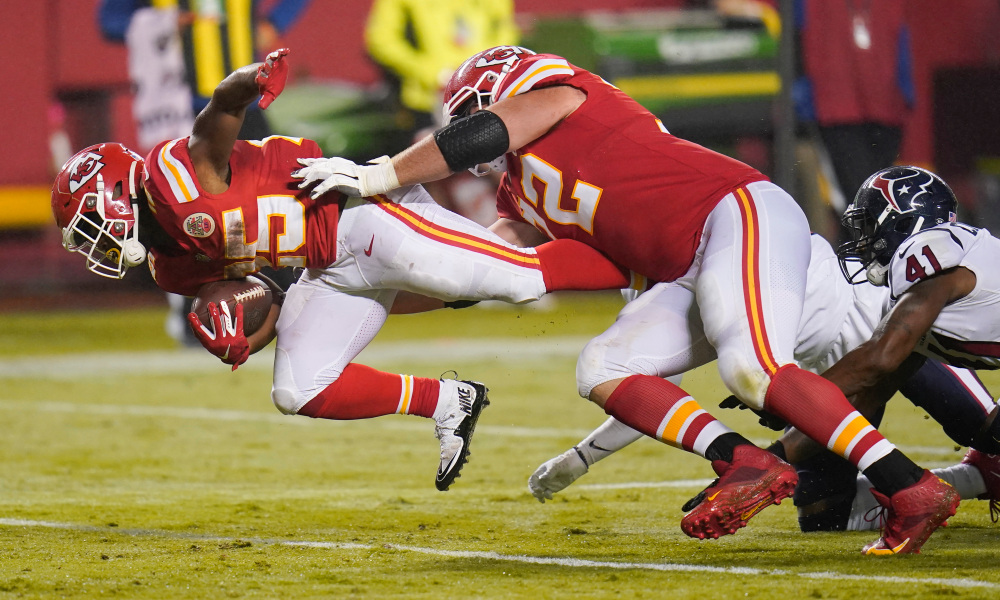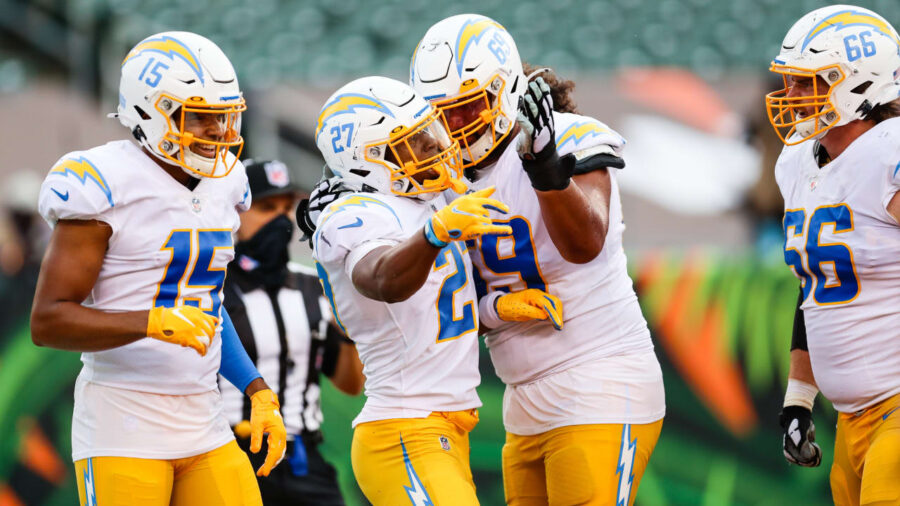NFL Game Scripts Week 2: Kansas City Chiefs @ Los Angeles Chargers
Kansas City Chiefs Offense vs. Los Angeles Chargers Defense
The Run Game

While the Chiefs are firmly a pass-first Offense, and so they should be with Patrick Mahomes under Center, they have the potential to be a formidable rushing team as well. Rookie Clyde Edwards-Helaire showed patience and burst in Week 1, and found holes through the middle.
The Chiefs may look to use FB Anthony Sherman more as a blocker when running to the outside, especially to counteract the edge presence of Melvin Ingram and Joey Bosa. Between the tackles, the Chiefs will let Edwards-Helaire find space on his own, with MLB Kenneth Murray tasked with closing up the holes. Although the Chargers will have Kyzir White in as a second LB in the middle, testing the Chargers’ run defense early will set up play action later in the game, or at a minimum give Mahomes more time.
The Chiefs will be cautious of the DEs they face in this one, but were able to win one-on-one matchups with their OL against JJ Watt and co. Running on either side of the Guards early, instead of towards the outside, could compact the Chargers’ defense, setting up space on the outside. Although they should have success running the ball in the first half, the Chiefs will build up a lead passing the ball early on, and run out the clock in the second half.
The Passing Game
The Chiefs have one of the more difficult passing attacks to defend in the league, and it is more to do with the individual skillsets of their receiving options rather than the scheme. The Chargers will spend much of the game in their nickel package, especially as the Chiefs tend to use 3 WR sets often, not to mention TE Travis Kelce primarily being a receiver as well.
While slot CB Desmond King could restrict WR Sammy Watkins at times, or jam Mecole Harman, the bigger question is who can contain Tyreek Hill and Kelce. CB Casey Heyward will stay on the right side of the defense, which allows the Chiefs to move Hill to the other side of the field, but Chris Harris could move inside against Kelce. Getting Safety help against Hill will happen all game, but it instead opens up other spaces, and is a choice the Chargers will weigh up.
Kansas City will focus on giving their receivers chances to run after the catch, as their speed and agility makes them more dangerous weapons with the ball in their hands. While Hill, Hardman and Demarcus Robinson could be used with end-arounds and jet sweeps, their speed should see them run vertical-type routes often and early. With separation coming from these receivers by outpacing their opposing CBs, they will run deep routes throughout the first half to open space underneath, and force the defense to back off.
Moreover, the Chiefs will embed screen concepts to get downfield blockers. By using their tackles and allowing Bosa, Ingram and Perryman to overpursue, Kelce, Edwards-Helaire and the WRs can be set up with space in front of them and add extra yards. Releasing Kelce and Edwards-Helaire into the flats and short curls around the hash marks gives them the option to head to the outside if there are receivers to block, especially Watkins and Robinson, or to cut back inside where the OL can get downfield and clear lanes.
As the Chiefs get into the second and third quarters, more of their passing game will come from unbalanced formations, getting their speedsters the ball on short throws to then make plays, instead of intricate route concepts. Once the Chiefs have success downfield and with their screen game, they can use the run with a mixture of deep and short throws, as well as Kelce on dig, post and corner routes to find space over the middle.
What should we expect to see on Sunday?
The Chiefs will continue to take whatever the Chargers give them on defense, and spread the defense out to keep them guessing. They will take downfield shots early to open up the screen game, and then incorporate additional runs up the middle. With individuals winning their matchups, the Chargers will be forced to blitz early and take Mahomes down before he can get in a rhythm. Failing this, Los Angeles are in danger of being exploited all over the field.
Los Angeles Chargers Offense vs.Kansas City Chiefs Defense
The Run Game

With perhaps their best OL in years, the Chargers can run more effectively as well. Austin Ekeler will be their workhorse, and serves as an equal threat in the passing game. While Justin Jackson could see a series or two, or some third-down action, Ekeler figures to be used as the feature back. While they have the potential to run a lot of RPOs with Tyrod Taylor at QB, the Chargers are instead focusing on getting Ekeler outside of the Tackles. Although this can allow Taylor to pull the ball back in and cut inside oncoming defenders, if the Chiefs can get an edge rusher in quickly, especially against the LT Sam Tevi, the Chargers will instead resort to check-downs and screens to Ekeler in the flat.
Los Angeles will need to get creative with their run game though, as the Chiefs have dominant players on the inside and outside of their DL. They could look to have both RBs on the field, and fake handoffs to one or the other, allowing either toss plays or screens once the Chiefs’ defense starts rushing the pocket. With the Chiefs preferring to have an extra DB as their base defense, it allows the Chargers to run up the middle with fewer defenders, but gives the Chiefs more speed outside the box, and better chances to make contact or slow down the RBs. The Chargers could also use two TE sets more than Week 1, or even jumbo sets with an extra OL, just to get extra blockers on the edge and spring Ekeler or Jackson on the outside.
The Chargers will need to use some trick plays in the run game, and either adjust their formation quickly or disguise their runs if they are to have any success. Draws and counters from shotgun formation could be another way to integrate RPOs, but the speed of the Chiefs up front will make it hard for the Chargers to get going on the ground. Early on they need to attack up the middle, at the very least to soften it up for later in the game, and to make their plays less predictable. But as the game goes on, especially if they fall behind, Ekeler and Jackson are instead going to be blockers for Taylor or check downs in the flats.
The Passing Game
With WR Mike Williams out with injury for a few weeks, the Chargers are thin at receiver. Although they should move Ekeler out of the backfield as a receiver early on to spread the defense out, the Chargers should experiment with different alignments as well. Stacking WRs, or putting them in a bunch, could cause enough confusion and commotion after the snap to hide Keenan Allen’s route.
Allen is the team’s best weapon on offense, and although the Chiefs don’t have a CB that can match up with him consistently, without anyone else to take attention away from him, Kansas City can double team him all day without worrying about leaving anyone else exposed. Getting Allen to run slants and option routes could free him up, but he has to get going early. Taylor failing to find Allen for the first quarter will prevent him from opening up other players as the game goes on.
One other player that can be a big threat for the Chargers is TE Hunter Henry, although he’s likely to see a combination of Daniel Sorenson and Tyrann Mathieu in coverage. Getting Henry to run 5-10 yard hitch, in and out routes could help him box out the defender, but requires Taylor to place the ball well on his throws, and not create too many contested catches. Henry should be targeted early to force the Chiefs to focus on him more, and with him and Allen dominating the key pieces in the secondary, it will free up other players.
Aside from Ekeler and Jackson out of the backfield or slot at times, the Chargers will have Joe Reed and Jason Moore running fades and comebacks on the outside. From the slot, rookie KJ Hill could find space on slants and in routes, especially with Allen and Henry stretching the field. As the game goes on, getting these secondary and tertiary receivers open will allow the Chargers to move the ball, especially if the Chiefs’ CBs are struggling against Allen.
The biggest question for the Chargers is Taylor at QB. He doesn’t have a dominant arm, and won’t be asked to throw deep too often. His accuracy is inconsistent, so giving him quick reads and getting the ball out quickly for short gains could help him gain momentum as the game goes on. The biggest question for him will be if he can read the field cleanly and hit open receivers downfield when they get open, or recognise when the coverage has backed off and he can scramble for several yards. The Chargers may design plays for him to run early, hoping it causes the Chiefs to commit more defenders at the line, creating some bigger windows downfield as the game progresses.
What should we expect to see on Sunday?
The Chargers need to be deceptive with their RBs, and focus on getting their best weapons into the best matchups possible. Moving Ekeler around to create mismatches with CBs, targeting Henry early, and finding the WR2 and WR3 on short passes will allow Allen to open up a little, which will keep the Chargers with a chance of moving the ball more effectively. The Chiefs will use their defensive line to create pressure, hoping Tyrod Taylor doesn’t escape the pocket and cause damage with his legs. The Chiefs’ secondary can limit Henry’s and Allen’s impact, but could be left open to other receivers at times. Minimising the damage by these players will result in the Chiefs teeing off and blitzing more, especially if they build up a big lead.

